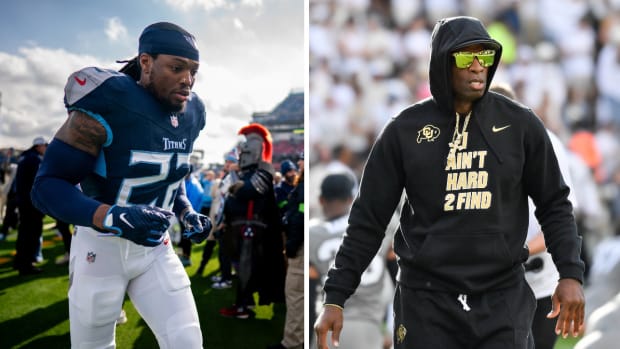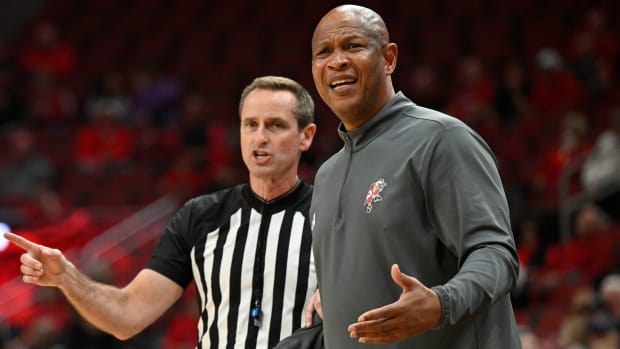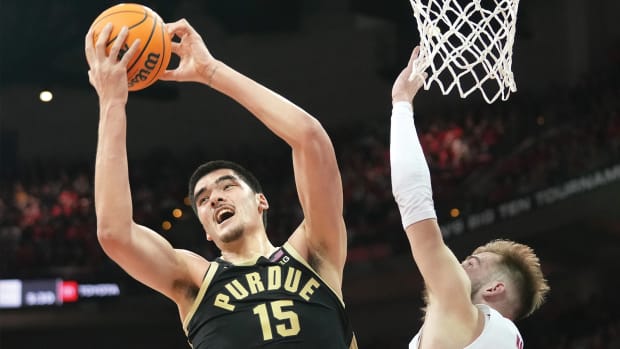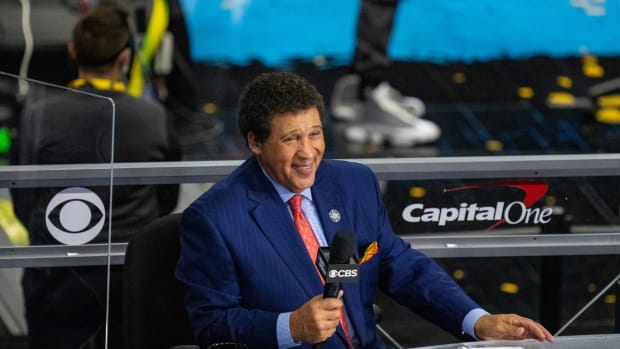'We've Done It to Ourselves': A Divided NCAA Membership Delays NIL Vote as Pressures Mount
In January, the NCAA was on the brink of passing groundbreaking legislation to grant athletes the right to earn compensation on endorsement deals, business ventures and public appearances.
The exhaustive 30-plus page legislative document governing name, image and likeness (NIL)—in the works for more than a year—marked progress forward in the NCAA’s march to modernize its archaic rules. The legislation struck down decades of prohibitions, freeing athletes to profit on their images like any other college student—a victorious win for athletes around the country.
And then, days before the organization's virtual annual summit in mid-January, the governing body shelved the proposal.
Now, six months later, there is still no rule to govern athlete compensation, and the wait is expected to extend several more days. The NCAA’s chief policy-making board, the Division I Council, is not, as of now, scheduled to vote on NIL legislation this week, sources tell Sports Illustrated, again shelving the vote, this time to review an alternative model from a group of conference commissioners and to digest the Supreme Court’s Monday decision. The council has reserved a time next Monday to potentially cast the historic vote.
Internally, while pressures around the organization continue to mount, NCAA members are more fractured and divided as ever over the most significant piece of legislation in the association’s history.
In just nine days, a cascade of state NIL laws threaten to plunge college sports into a proverbial inequitable playing field, and on Monday, the Supreme Court rocked the association with a unanimous decision in the Alston case that could further impact the association’s NIL rules.
But the latest complication comes from within the NCAA membership itself. A group of six conference commissioners, three from the Power 5, are encouraging the DI Council to scrap its long-readied NIL proposal and instead adopt an alternative plan. Under the plan, the NCAA would exempt itself from NIL completely. Schools in states with an NIL law may follow that law without penalty, and schools located in states without a statute are granted permission to each create and administer their own NIL policy, as long as they use two guiding principles: no pay for play or recruiting inducements.
The latest revelation has further delayed the long-awaited NIL vote and hurtled high-level administrators into a space of disagreement during the 11th hour of a process that began two years ago.
“In hindsight, I’m saying ‘S---, why didn’t we act on this in January?’” says one NCAA decision-maker. “We’ve done it to ourselves. Everybody has their own agenda. If we come out of this without doing anything, we are dysfunctional.”
“What a mess,” says another, both granted anonymity to speak with SI. “That’s exactly the right term. It’s a mess. If it doesn’t pass, you’ve got chaos.”
In fitting timing, on the eve of the DI Council’s two-day meeting, the Supreme Court ruled that the NCAA’s policies limiting educationally-related costs were in violation of antitrust law, opening the door for schools to offer athletes extra benefits as long as they are tethered to academics. But maybe even more significant is the ruling’s immediate impact on the NCAA’s NIL legislation and the long-term effects of a scathing rebuke from Justice Brett Kavanaugh.
“Traditions alone cannot justify the NCAA's decision to build a massive money-raising enterprise on the backs of student athletes who are not fairly compensated,” Kavanaugh wrote. “The NCAA is not above the law.”
In its opinion, the high court undercut most of the NCAA’s broader amateurism defense, cracking the door for more legal challenges toward the association’s crumbling bedrock of amateurism rules. Kavanuagh’s harsh concurrence is especially troubling, legal experts say, as one of the court’s most conservative justices hammers the NCAA’s model. It is yet another complexity over how the organization will choose to govern NIL.
“This decision not only puts at risk any new legislation that might be put forward on NIL, but it puts at risk all restrictions the NCAA has on athlete compensation,” says Gabe Feldman, a Tulane law professor and expert on NIL matters.
The NCAA’s long-constructed NIL legislative proposal is rife with athlete restrictions. Most notably, the proposal prohibits athletes from using school marks and logos in endorsements, outlaws them from using school facilities for NIL activities and bans them from using university-provided content in NIL ventures.
“I don’t know how you can read the Supreme Court decision and not be concerned about being overly restrictive,” says one member of the DI Council. “It should cause everybody to take a deep breath. The proposal establishes restrictions.”
Meanwhile, many of the state NIL laws give athletes more freedoms in their NIL activities, causing potential conflicts among differing state laws and between state law and the NCAA’s proposal. The conflict is at the root of the alternative model floated by six commissioners. Greg Sankey (SEC), Larry Scott (Pac-12), Jim Phillips (ACC), Keith Gill (Sun Belt), Charles McClelland (SWAC) and Richard Ensor (Metro Atlantic) sent a letter on Friday to the DI Council encouraging them to use their suggested model in order to avoid conflicts with state laws, offer a more equitable playing field and avoid an avalanche of antitrust suits.
“We do not believe it is prudent, appropriate, or in the best interests of student‐athletes for the NCAA to move forward with adoption of NIL rules that are, upon passage, invalid on their face in most states that have adopted an NIL law,” the commissioners wrote in documents obtained by SI and available here.
The commissioners are against several other provisions that were or are a part of the NCAA’s proposal: (1) A third-party administrator, plans for which have been discontinued; (2) extending of NIL rules to recruits; (3) using a waiver system to grant numerous waivers to accommodate various state laws.
While examining both the original proposal and the alternative option last week, McClelland told SI that the alternative option provided more flexibility at an uncertain time. He described it as a temporary move until a federal bill is passed on Capitol Hill.
The alternative plan is “something we should debate before any vote,” he says.
While the alternative plan would put most, if not all, schools operating under similar NIL rules, the proposal grants athletes freedoms well beyond what some administrators believe is practical.
“It goes way too far,” says one.
“Clearly,” says another, “we have differences of opinion on the legal issues around this.”
The divide among top-level officials continues the splintering of college sports just months after COVID-19 caused historic friction among the ranks. In fact, sources tell SI that a fifth FBS conference, the MAC, is in support of the alternative model, meaning at least half (five) of the 10 FBS conferences are behind it.
Leaders now must grapple with hurriedly evaluating this alternative model while they digest the Supreme Court ruling and watch as more states pass NIL laws. A whopping 19 states have passed laws, six of those that take effect July 1, as shown on the above map.
“It feels like the NCAA is between three rocks and four hard places,” Feldman says. “There are so many forces closing in on them.”
The Supreme Court ruling, above all, means the NCAA is not immune to antitrust laws, thus plunging the organization into more sticky situations with its NIL concepts, says Darren Heitner, a sports law professor based in Florida who helped draft that state’s NIL law.
“It must be extremely careful because it will be sued if it restricts athletes from benefiting from their rights of publicity,” he says. “The NCAA may have felt cautiously confident in its prior proposal, but that’s probably out the window now and there’s a lot more credence paid to that alternative proposal from commissioners.”
This could all, in a way, be solved by Congress. For more than a year, the NCAA has urged lawmakers on Capitol Hill to pass a federal bill to govern NIL in a uniform way. Five US senators have been entrenched in bi-partisan negotiations this spring seeking compromise legislation.
Though talks have stalled and a July 1 deadline is unreachable, some experts and US senators say the Supreme Court’s ruling, while a stinging defeat for the NCAA, may galvanize lawmakers in seeking compromise.
Sen. Maria Cantwell, as the chair of the Commerce Committee, the most powerful lawmaker in the NIL debate, says the court’s decision “gives new urgency” to negotiations. Sen. Richard Blumenthal, at the center of negotiations, told SI that the ruling is “a gigantic kick in the butt” for congressional talks and that it’s possible an agreement can be reached by the time lawmakers break for August recess.
“It clears away the myth of amateurism,” he says. “Unanimous Supreme Court decisions are rare, particularly for this court. There will be additional force as a result of this one. 'Force' meaning not only legal persuasiveness, but also practical support for athletes rights."
Meanwhile, athletes could see an immediate benefit from the high court’s primary ruling, granting schools the right to provide education benefits to athletes beyond tuition. They include unlimited graduate school, vocational and study abroad scholarships, paid internships, computers and equipment, tutoring and up to $5,900 cash for academic awards, says Jeffrey Kessler, the victorious attorney in the Alston case.
“It doesn’t force schools to do anything. It permits them,” Kessler says. “I expect a lot of them to respond quickly. Each school will study for itself and some conferences may study as a conference and take action. I expect every school in the Power 5 to quickly offer these benefits.”
Around the nation on Monday, conference commissioners were expected to gather virtually with their league administrators to discuss their approach to the new benefits. While an NCAA-wide policy governing educational benefits could be seen as colluding—bringing on more antitrust issues—individual conferences are expected to determine their membership’s path.
There is concern among some that schools will use these extra educational benefits as inducements.
“You can promise to send a young man or woman to a Wall Street firm for an internship that pays them a million dollars. Hey, it’s based on their education!” says Len Elmore, a former ESPN broadcaster, attorney and member of the Knight Commission, a longstanding independent group that promotes reforms that support the educational mission of college sports.
“If the school does that, will the player sign with them? You can see what I’m saying. Education benefits are not inherently bad. But based on the lack of institutional integrity we’ve seen, it makes this vulnerable to exploitation.”
In the meantime, the NCAA has more pressing issues. The organization has nine days to pass NIL legislation. If not, schools in 44 states would operate without NIL freedoms while athletes attending schools in six others—Texas, Mississippi, New Mexico, Florida, Georgia and Alabama—strike endorsement deals.
Will the DI Council next Monday pass their 30-plus page document? Will it instead vote for the alternative plan suggested by six commissioners? Or will NCAA president Mark Emmert issue a blanket waiver of some kind?
Either way, says Elmore, the NCAA is in a bind.
“This is bordering on chaos for them, which could have been avoided,” he says. “Action should have been taken a long time ago.”
More College Coverage:
• Why 12 Worked: Inside the Making of a New Playoff Model
• College Football Looks to Be Getting Playoff Expansion Right
• The Secluded Florida Region Where Football Coaches 'Find Peace'
• The Pac-12 Puts Its Lagging Reputation—and Its Future—in Unexpected Hands





